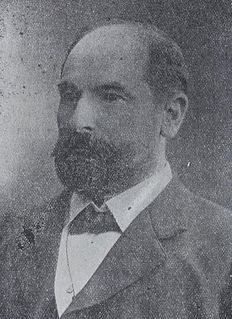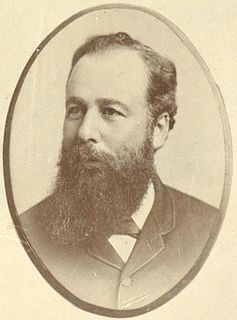Frank Andrew Halleday was an Australian politician. He was a member of the South Australian Legislative Council from 1938 to 1943.

John Dunn Sr. was a flour miller in the early days of the colony of South Australia; a parliamentarian, philanthropist and a prominent citizen of Mount Barker, South Australia.

Henry (Harry) Adams was an Australian politician and trade unionist. He was a United Labor Party member of the South Australian Legislative Council from 1894 to 1902, representing Central District. He also served as president of the United Trades and Labour Council of South Australia and was a long-serving secretary of the Railways Service Association.

Heinrich Albert Alfred von Doussa was an Australian businessman and politician. He was a member of the South Australian Legislative Council from 1901 to 1921, representing Southern District.
William Bowman was a pioneer farmer, grazier, flour miller and merchant on the Finniss River near Middleton, South Australia.
William George James Mills, generally referred to as W. G. Mills, was a sheep breeder and politician in South Australia.
The Courier is a weekly newspaper published in Mount Barker, South Australia. For much of its existence its full title was The Mount Barker Courier and Onkaparinga and Gumeracha Advertiser, later shortened to The Mount Barker Courier.
Charles Morris Russell Dumas, generally referred to as Charles M. R. Dumas, was a South Australian newspaper proprietor and politician. He was the proprietor of The Mount Barker Courier and Onkaparinga and Gumeracha Advertiser for 54 years and served as president of the South Australian Provincial Press Association from 1915 until his death. He was a member of the South Australian House of Assembly from 1898 to 1902, representing the electorate of Mount Barker.
Charles Richard Wilton was a journalist in the State of South Australia, a longtime literary editor of The Advertiser and authored, under the pen name of "Autolycus", a long-running weekly column in The Courier of Mount Barker.
Sir Frederick Lloyd Dumas, generally known as "Lloyd Dumas" or "F. Lloyd Dumas", was a journalist and politically influential newspaperman in Victoria and South Australia.

Frank Clement Staniford was an Australian politician. He represented the South Australian House of Assembly multi-member seat of Murray from 1924 to 1927 and 1930 to 1933 for the Labor Party. He was Chairman of Committees under Lionel Hill in his second term, and was Minister for Education, Minister for Immigration, Minister for Labour and Employment and Minister for Local Government in the short-lived Richards Ministry of 1933, following the 1932 Labor split.

John Moule was a wheat merchant and politician in the colony of South Australia.
William Rodolph Wigley was a lawyer and politician in the British colony of South Australia.
The Wilmington railway line was a railway line on the South Australian Railways network. It opened from Gladstone to Laura on 2 June 1884. It was extended from Laura to Booleroo Centre on 13 April 1910, and to Wilmington on 20 July 1915.
The Australische Zeitung was a weekly German-language newspaper published in Tanunda, South Australia from 1860 until it ceased publication during World War I in 1916 due to anti-German sentiment. The newspaper also existed in a variety of earlier names or merged publications, reflecting the fluid nature of the newspaper industry in Victorian gold rush era colonial South Australia. The long history of German language Australian newspapers reflects the considerable German-speaking population which settled in South Australia in the nineteenth century.
The Corporate Town of Murray Bridge was a local government area in South Australia from 1924 to 1977.
Thomas Good was a merchant of Adelaide, South Australia, a founder of the wholesale drapery business of Good, Toms & Co.
Henry Jackson Moseley was a builder and publican in the very early days of the British colony of South Australia.
Carl Heinrich Conrad Loessel or Lössel, generally known as Carl or Carl Heinrich Loessel, was a German-born Lutheran pastor and schoolteacher in the early days of the British colony of South Australia. He was a founder of the Lutheran Church in Flinders Street, Adelaide, and pastor of the church at Lobethal.
John James Bonnar was a schoolteacher and lawyer in the early days of the colony of South Australia.











